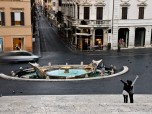The Bocca della Verità, or “Mouth of Truth” in English, is a relic of Ancient Rome. It is a large disc made of marble, which shows in relief the carved face of a man. A long-standing legend states that a liar who places his or her hand inside the face’s mouth will have it bitten off. The legend has led to the carving becoming extremely popular with tourists.
Background and History
The original reason for the creation of the carving is still not known, although one theory is that it was simply intended as a cover for a drain. The Temple of Hercules Invictus, the site of which is close by, had a circular opening in its roof. This was known as an oculus, and was closely matched to a similar opening in the roof of the Pantheon. The most popular explanation for its presence is that the drain was used to wash away blood from sacrifices. In that time, cattle merchants frequently sacrificed animals to gain favor with Hercules.
The Bocca remained in its original location throughout the Roman era and for a number of centuries after the empire had fallen. However, it is likely to have been removed at some point in the 13th century, after which it was moved to a spot by the wall of Cosmedin’s Church of Santa Maria. Around four centuries after this, the face was moved again, and since then it has been located inside the church’s portico.
The Legend
The face shown on the huge mask is likely to be that of Oceanus, the god of the World Ocean, which the Romans believed surrounded the Earth. The structure weighs more than one ton due to its marble construction. The fact that the face’s mouth, nostrils, and eyes are all open contributed to the association of the carving with honesty and the detection of lies.
Many people in the Middle Ages believed that the legend was true, and that the face’s mouth would snap shut if a lie was told by the person whose hand was between its jaws. The Bocca was sometimes used by secular judicial authorities, especially in cases of adultery or perjury. In modern times, the legend became increasingly well known in Italian culture, and the poet Giaoachhino Belli wrote about it in the 19th century.
Modern Representations
The wider English-speaking world was introduced to the Bocca della Verità in 1953, when it played a significant role in the hit movie Roman Holiday. In the film, the truthfulness of stars Gregory Peck and Audrey Hepburn forms an important aspect of the plot. Although this remains the most prominent appearance of the face on the big screen, a few other movies have either copied or parodied the legend.
In some other parts of the world, especially in Western Europe, replicas of the Bocca have become popular entertainments in fairgrounds and arcades. Although most of the replicas are much smaller than the ancient carving itself, one at California’s Pikake Botanical Gardens copies the dimensions of the Roman original.





































